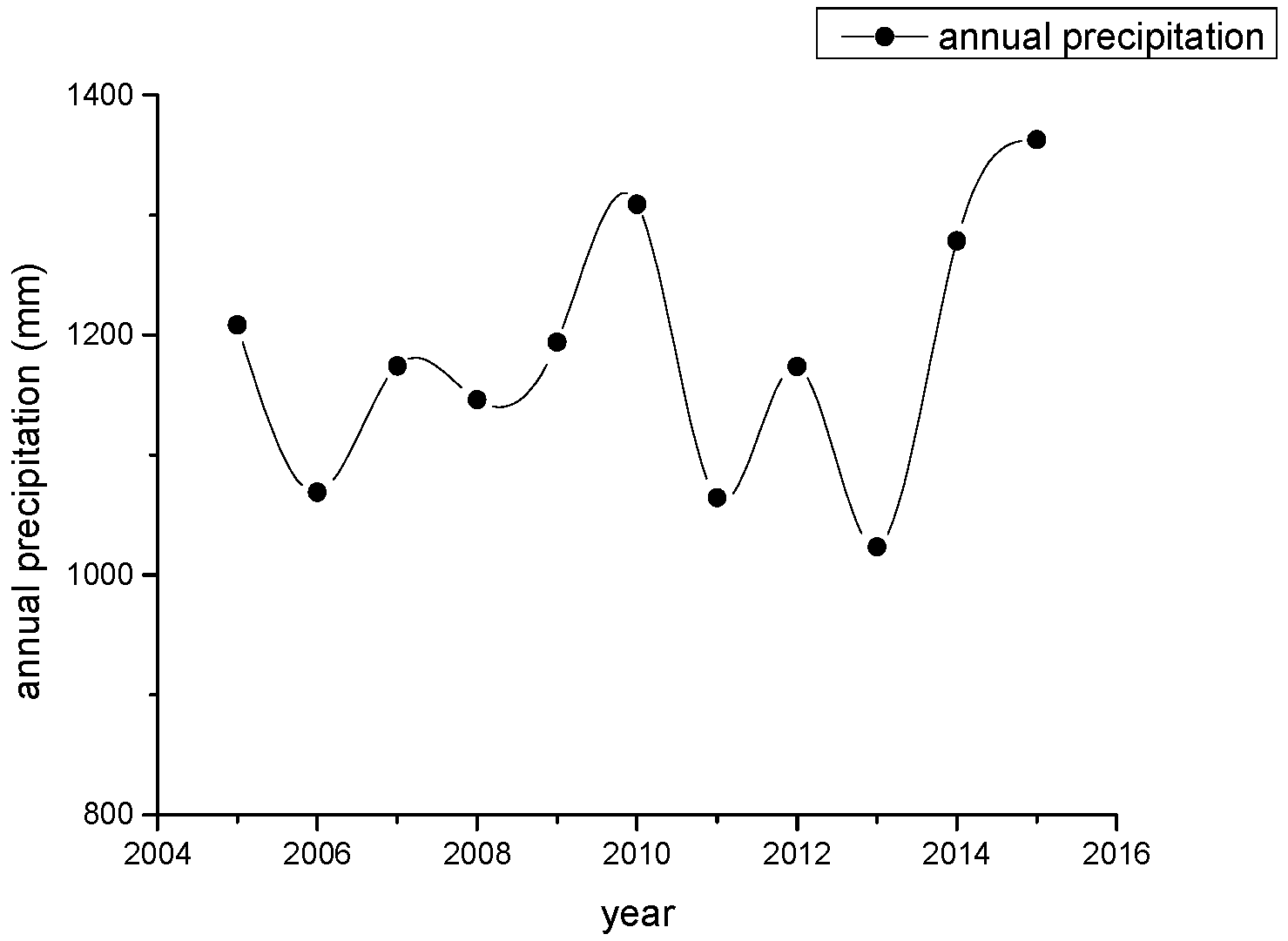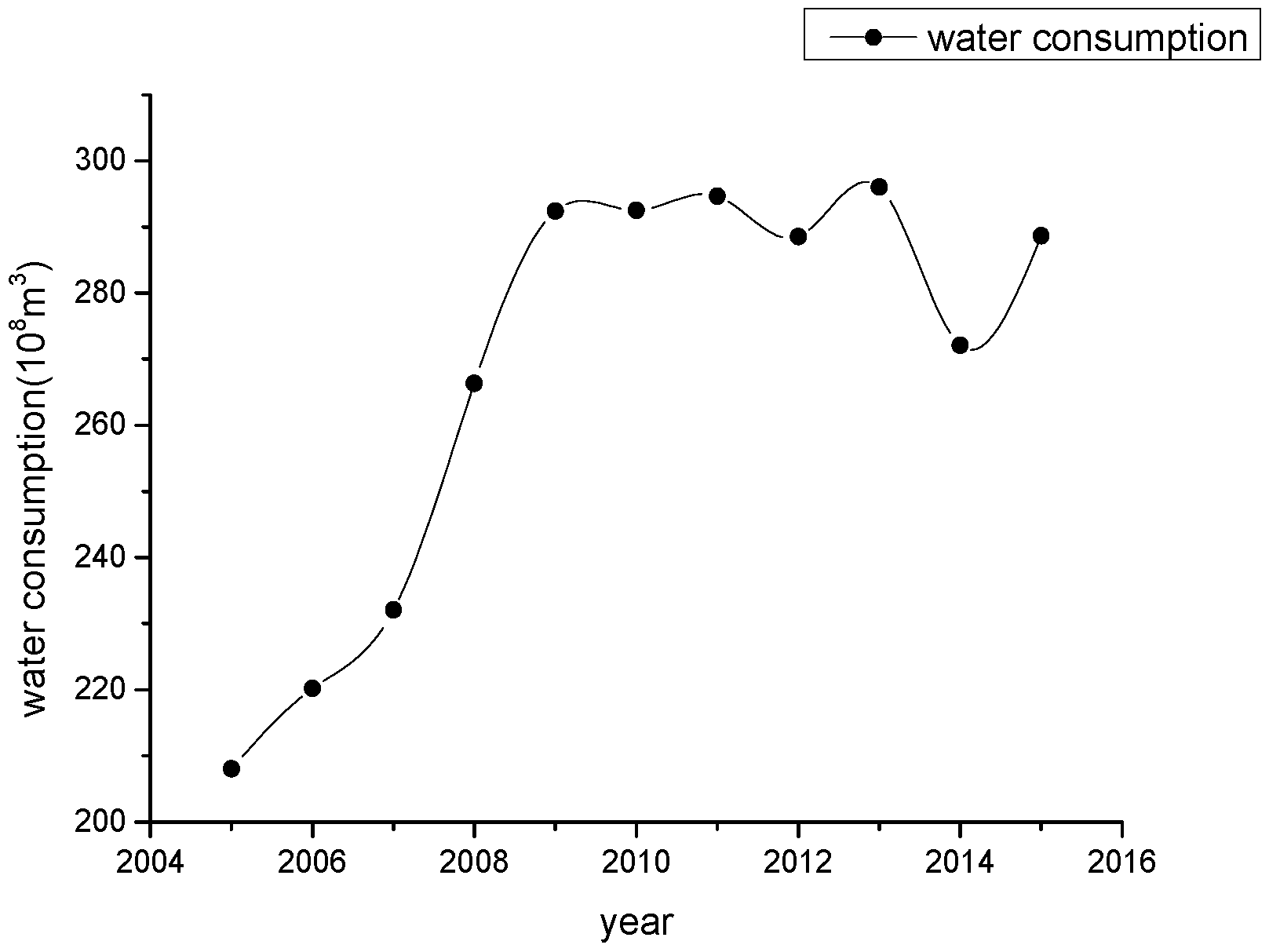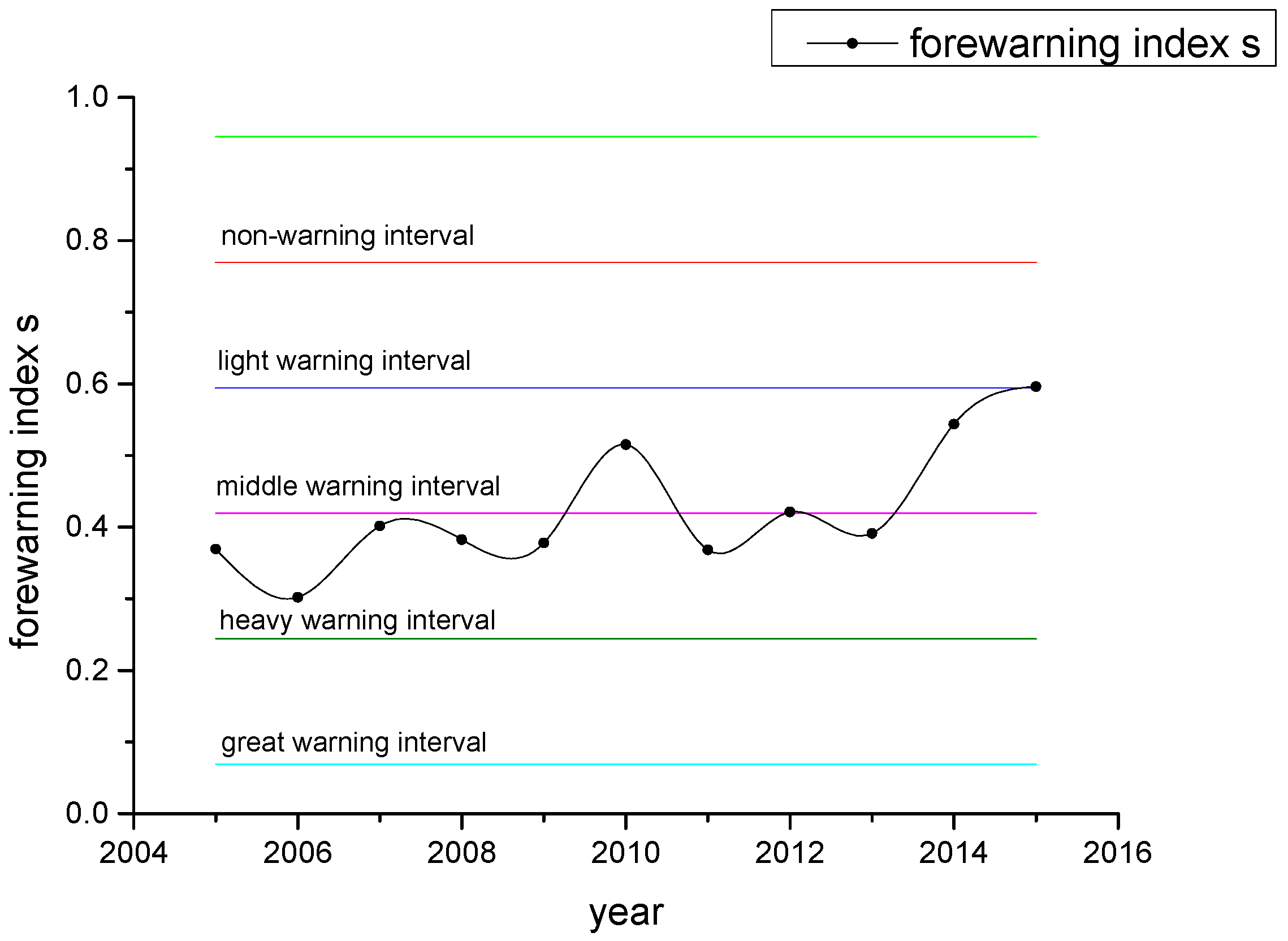Forewarning Model of Regional Water Resources Carrying Capacity Based on Combination Weights and Entropy Principles
Abstract
:1. Introduction
2. Summary of the Study Area
2.1. Hydrological and Climatic Conditions
2.2. Situation of Water Resources
2.3. Situation of Water Consumption
3. Forewarning Model and Application
3.1. Construction of the Index System and the Grade Standard
3.2. Determination of Subjective Weight by AGA-FAHP
3.3. Determination of Objective Weight by AGA-PP
3.4. Determination of Combination Weight by Entropy of Information
3.5. Calculation of Comprehensive Forewarning Index
4. Results and Discussions
4.1. Determination of the Warning Status of the Water Resources Carrying Capacity
4.2. Results Comparison
4.3. Results Analysis
5. Conclusions
- (1)
- In this model, for the determination of the weight of each index, the forewarning index system and the grade standards of water resources carrying capacity were established, according to the actual situation of the study area. AGA-FAHP was used to calculate the subjective weight of each index. AGA-PP was used to calculate the objective weight of each index. In addition, the minimum relative information entropy principle was used to calculate the combination weights. Then, the forewarning comprehensive index was calculated to find out the relationship between the forewarning comprehensive index and the membership degree of “non-warning”. On this basis, the forewarning model of the regional water resources carrying capacity was established. This model combined expert experience and objective information in the research area. In addition, the calculation results were reasonable. This can be used in other forewarning systems by modifying the index system and grade standards for its universality.
- (2)
- As a basic natural resources and strategic economic resources, water resources are an important guarantee for the sustainable development of economy and society. Therefore, the water resources carrying capacity forewarning, based on theory and technology, has an important significance for guiding the water resources development and management, scientifically and reasonably. With this forewarning model, we can evaluate the status of the water resources carrying capacity, study the variation trend of water resources carrying capacity and analyze the main influence factors of the water resources carrying capacity. Based on this we can forecast the status of the water resources carrying capacity, guide the strategy of the development and utilization of water resources, according to the results of forewarning and the main influence factors, and find ways to improve the water resources carrying capacity.
- (3)
- In order to improve the water resources carrying capacity, product consumption must be reduced and the water recycling rate must be improved through scientific management and technological innovation. The efficient use of water resources, the reasonable development and utilization of water resources must be ensured through the optimal allocation of water resources and the adjustment of economic structure. Overall, it is time to promote the construction of a water-saving society and building a harmonious environment between human and water.
Acknowledgments
Author Contributions
Conflicts of Interest
References
- Mei, H. Advances in study on water resources carrying capacity in China. Procedia Environ. Sci. 2010, 2, 1894–1903. [Google Scholar] [CrossRef]
- Xiong, H.; Fu, J.H.; Wang, K.-L. Evaluation of water resource carrying capacity of Qitai Oasis in Xinjiang by entropy method. Chin. J. Eco-Agric. 2012, 20, 1382–1387. [Google Scholar] [CrossRef]
- Fu, X.; Ji, C.M. A comprehensive evaluation of the regional water resource carrying capacity—Application of Main Component Analysis Method. Resour. Environ. Yangtza Basin 1999, 2, 168–173. [Google Scholar]
- Zhou, L.; Liang, H. A Study on the Evolution of Water Resource Carrying Capacity in Karst Area Based on Component Analysis and Entropy. J. Nat. Resour. 2006, 21, 827–833. [Google Scholar]
- Gong, L.; Jin, C. Fuzzy comprehensive evaluation for carrying capacity of regional water resources. Water Resour. Manag. 2009, 23, 2505–2513. [Google Scholar] [CrossRef]
- Liang, M.; Wang, Z.; Liu, J. Evaluation model of water resources carrying capacity based on factor analysis. Yellow River 2010, 32, 62–65. [Google Scholar]
- Zhao, Z.; Li, W.; Wang, C. Study on Water Resources Carrying Capacity in Ningxia Based on Principal Component Analysis and Factor Analysis. Hydrology 2017, 37, 64–72. [Google Scholar]
- Chen, N.X.; Ban, P.L.; Zhang, W.B. Fuzzy evaluation of the water resources carrying capacity based on the maximum entropy theory. J. Irrig. Drain. 2008, 27, 57–60. [Google Scholar]
- Li, F.; Chen, Y.; Li, W. The Application of Set Pair Analysis Based on Entropy Weight to Evaluation of Sustainable Water Resources Utilization—A Case Study in the Three Sources of Tarim River. J. Glaciol. Geocryol. 2010, 32, 723–730. [Google Scholar]
- Feng, L.H.; Zhang, X.C.; Luo, G.Y. Application of system dynamics in analyzing the carrying capacity of water resources in Yiwu City, China. Math. Comput. Simul. 2008, 79, 269–278. [Google Scholar] [CrossRef]
- Guo, Q.; Tian, Z.; Zeng, L. Application of AGA-FAHP in Bids Evaluation of Construction Projects. Water Sav. Irrig. 2010, 9, 62–64. [Google Scholar]
- Jin, J.; Yang, X.; Wei, Y. System Evaluation Method Based on Fuzzy Preferential Relation Matrix. Syst. Eng. Theory Methodol. Appl. 2005, 14, 364–368. [Google Scholar]
- Jin, J.; Yang, X.; Ding, J. An Improved Simple Genetic Algorithm—Accelerating Genetic Algorithm. Syst. Eng. Theory Methodol. Appl. 2001, 21, 8–12. [Google Scholar]
- Mon, D.L.; Cheng, C.H.; Lin, J.C. Evaluating weapon system using fuzzy analytic hierarchy process based on entropy weight. Fuzzy Sets Syst. 1994, 62, 127–134. [Google Scholar] [CrossRef]
- Tesfamariam, S.; Sadiq, R. Risk-based environmental decision-making using fuzzy analytic hierarchy process (F-AHP). Stoch. Environ. Res. Risk Assess. 2006, 21, 35–50. [Google Scholar] [CrossRef]
- Wen, J.; Li, J.; Jin, J. Forewarning Model of Regional Water Resources Sustainable Utilization Based on Combined Weights and Entropy Principles. Water Resour. Power 2006, 24, 6–10. [Google Scholar]
- Xu, Z. Research on Compatibility and Consistency of Fuzzy Complementary Judgment Matrices. PLA UST 2002, 3, 94–96. [Google Scholar]
- Wang, M.; Jin, J.; Li, L. Application of method based on raga to assessment of sand liquefaction potential. Chin. J. Rock Mech. Eng. 2004, 23, 631–634. [Google Scholar]
- Jin, J.; Wang, M.; Wei, Y. Objective Combined Evaluation Model for Optimizing Water Resource Engineering Schemes. Syst. Eng. Theory Methodol. Appl. 2004, 24, 111–116. [Google Scholar]
- Friedman, J.H.; Tukey, J.W. A projection pursuit algorithm for exploratory data analysis. IEEE Trans. Comput. 1974, 100, 881–890. [Google Scholar] [CrossRef]
- Jones, M.C.; Sibson, R. What is projection pursuit. J. R. Stat. Soc. Ser. A (Gen.) 1987, 150, 1–37. [Google Scholar] [CrossRef]
- Jaynes, E.T. On the rationale of maximum-entropy methods. Proc. IEEE 1982, 70, 939–952. [Google Scholar] [CrossRef]
- Jin, J.; Yang, X. Real Coding Based Acceleration Genetic Algorithm. J. Sichuan Univ. Eng. Sci. Ed. 2000, 32, 20–24. [Google Scholar]
- Woodbury, A.D.; Ulrych, T.J. Minimum relative entropy: Forward probabilistic modeling. Water Resour. Res. 1993, 29, 2847–2860. [Google Scholar] [CrossRef]
- Bertsekas, D.P. Nonlinear Programming; Athena Scientific: Belmont, MA, USA, 1999. [Google Scholar]
- Huang, T.; Chen, C. Evaluation of water resources carrying capacity in Anhui Province based on analytic hierarchy process. J. Chifeng Univ. (Nat. Sci. Ed.) 2017, 33, 19–21. [Google Scholar]
- Liu, C.; Yu, W. Fuzzy comprehensive evaluation of water resources carrying capacity in Anhui based on entropy weight and AHP. Harnessing Huaihe River 2013, 2, 21–22. [Google Scholar]







| Forewarning Index System | Grade Standard | ||||
|---|---|---|---|---|---|
| Target Layer | Subsystem Layer | Index Layer | First Grade | Second Grade | Third Grade |
| Water Resources Carrying Capacity | holding power subsystem | x1 m3 | [1670, +∞) | [1000, 1670) | [0, 1000) |
| x2 104 m3/km2 | [80, +∞) | [50, 80) | [0, 50) | ||
| x3 m3/year | [450, +∞) | [350, 450) | [0, 350) | ||
| x4% | [40, +∞) | [25, 40) | [0, 25) | ||
| regulate and control subsystem | x5% | [0, 40] | (40, 70] | [70, +∞) | |
| x6 yuan | [24,840, +∞) | [6624, 24,840) | [0, 6624) | ||
| x7% | [90, +∞) | [70, 90) | [0, 70) | ||
| x8% | [95, +∞) | [70, 95) | [0, 70) | ||
| x9% | [5, +∞) | [1, 5) | [0, 1) | ||
| pressure subsystem | x10 L/d | [0, 70] | (70, 180] | [180, +∞) | |
| x11 L/d | [0, 100] | (100, 400] | [400, +∞) | ||
| x12 m3 | [0, 50] | (50, 200] | [200, +∞) | ||
| x13 people/km2 | [0, 200] | (200, 500] | [500, +∞) | ||
| x14% | 0, 50] | (50, 80] | [80, +∞) | ||
| x15 m3/mu | [0, 250] | (250, 400] | [400, +∞) | ||
| Weight | x1 | x2 | x3 | x4 | x5 | x6 | x7 | x8 |
| ws | 0.1334 | 0.1333 | 0.1066 | 0.0267 | 0.0594 | 0.0485 | 0.0294 | 0.0433 |
| wo | 0.0515 | 0.0589 | 0.0022 | 0.0523 | 0.0884 | 0.0309 | 0.0555 | 0.0137 |
| wc | 0.0952 | 0.1018 | 0.0176 | 0.0429 | 0.0833 | 0.0445 | 0.0464 | 0.0280 |
| Weight | x9 | x10 | x11 | x12 | x13 | x14 | x15 | |
| ws | 0.0194 | 0.033 | 0.0799 | 0.0624 | 0.081 | 0.0639 | 0.0799 | |
| wo | 0.0715 | 0.1344 | 0.1302 | 0.0001 | 0.1464 | 0.0868 | 0.0771 | |
| wc | 0.0428 | 0.0765 | 0.1172 | 0.0029 | 0.1251 | 0.0856 | 0.0902 |
| Serial Number | Values of Forewarning Indices | ||||||||
| x1 | x2 | x3 | x4 | x5 | x6 | x7 | x8 | x9 | |
| 1 | 1670.00 | 80.00 | 450.00 | 40.00 | 40.00 | 24,840.00 | 90.00 | 95.00 | 5.00 |
| 2 | 1603.00 | 77.00 | 440.00 | 38.50 | 43.00 | 23,018.40 | 88.00 | 92.50 | 4.60 |
| 3 | 1536.00 | 74.00 | 430.00 | 37.00 | 46.00 | 21,196.80 | 86.00 | 90.00 | 4.20 |
| 4 | 1469.00 | 71.00 | 420.00 | 35.50 | 49.00 | 19,375.20 | 84.00 | 87.50 | 3.80 |
| 5 | 1402.00 | 68.00 | 410.00 | 34.00 | 52.00 | 17,553.60 | 82.00 | 85.00 | 3.40 |
| 6 | 1335.00 | 65.00 | 400.00 | 32.50 | 55.00 | 15,732.00 | 80.00 | 82.50 | 3.00 |
| 7 | 1268.00 | 62.00 | 390.00 | 31.00 | 58.00 | 13,910.40 | 78.00 | 80.00 | 2.60 |
| 8 | 1201.00 | 59.00 | 380.00 | 29.50 | 61.00 | 12,088.80 | 76.00 | 77.50 | 2.20 |
| 9 | 1134.00 | 56.00 | 370.00 | 28.00 | 64.00 | 10,267.20 | 74.00 | 75.00 | 1.80 |
| 10 | 1067.00 | 53.00 | 360.00 | 26.50 | 67.00 | 8445.60 | 72.00 | 72.50 | 1.40 |
| 11 | 1000.00 | 50.00 | 350.00 | 25.00 | 70.00 | 6624.00 | 70.00 | 70.00 | 1.00 |
| 12 | 1135.70 | 51.57 | 319.26 | 26.06 | 28.92 | 7685.40 | 69.81 | 52.20 | 0.66 |
| 13 | 950.10 | 41.62 | 333.95 | 26.06 | 25.46 | 8820.18 | 56.41 | 64.30 | 0.59 |
| 14 | 1164.50 | 51.08 | 347.59 | 26.06 | 32.57 | 10,016.20 | 58.26 | 59.10 | 0.69 |
| 15 | 1139.80 | 50.13 | 395.13 | 26.06 | 38.09 | 11,261.22 | 71.02 | 72.20 | 0.61 |
| 16 | 1195.70 | 52.56 | 430.32 | 26.06 | 39.81 | 12,699.43 | 66.36 | 75.40 | 0.66 |
| 17 | 1578.20 | 67.33 | 428.45 | 27.53 | 31.15 | 15,092.34 | 67.03 | 78.50 | 0.79 |
| 18 | 1008.80 | 43.17 | 428.49 | 27.53 | 48.94 | 16,992.92 | 64.32 | 74.30 | 1.34 |
| 19 | 1170.60 | 50.53 | 418.08 | 27.53 | 41.17 | 17,072.43 | 69.42 | 71.40 | 1.31 |
| 20 | 974.54 | 41.99 | 427.22 | 27.53 | 50.55 | 17,262.21 | 71.92 | 70.50 | 1.37 |
| 21 | 1279.78 | 55.81 | 392.29 | 28.65 | 34.95 | 17,956.27 | 73.01 | 73.60 | 1.71 |
| 22 | 1495.31 | 65.54 | 415.40 | 28.65 | 31.58 | 18,665.40 | 73.68 | 78.90 | 1.70 |
| Serial Number | Values of Forewarning Indices | Warning Status | |||||||
| x10 | x11 | x12 | x13 | x14 | x15 | s(i) | f(i) | ||
| 1 | 70.00 | 100.00 | 50.00 | 200.00 | 50.00 | 250.00 | 0.9449 | 1.00 | -- |
| 2 | 81.00 | 130.00 | 65.00 | 230.00 | 53.00 | 265.00 | 0.8573 | 0.90 | -- |
| 3 | 92.00 | 160.00 | 80.00 | 260.00 | 56.00 | 280.00 | 0.7697 | 0.80 | -- |
| 4 | 103.00 | 190.00 | 95.00 | 290.00 | 59.00 | 295.00 | 0.6821 | 0.70 | -- |
| 5 | 114.00 | 220.00 | 110.00 | 320.00 | 62.00 | 310.00 | 0.5945 | 0.60 | -- |
| 6 | 125.00 | 250.00 | 125.00 | 350.00 | 65.00 | 325.00 | 0.5069 | 0.50 | -- |
| 7 | 136.00 | 280.00 | 140.00 | 380.00 | 68.00 | 340.00 | 0.4193 | 0.40 | -- |
| 8 | 147.00 | 310.00 | 155.00 | 410.00 | 71.00 | 355.00 | 0.3317 | 0.30 | -- |
| 9 | 158.00 | 340.00 | 170.00 | 440.00 | 74.00 | 370.00 | 0.2441 | 0.20 | -- |
| 10 | 169.00 | 370.00 | 185.00 | 470.00 | 77.00 | 385.00 | 0.1565 | 0.10 | -- |
| 11 | 180.00 | 400.00 | 200.00 | 500.00 | 80.00 | 400.00 | 0.0689 | 0.00 | -- |
| 12 | 89.04 | 386.10 | 369.10 | 465.00 | 35.50 | 320.30 | 0.3694 | -- | heavy |
| 13 | 85.69 | 393.80 | 361.90 | 470.00 | 37.10 | 337.60 | 0.3022 | -- | heavy |
| 14 | 91.13 | 305.90 | 287.90 | 479.00 | 38.70 | 287.30 | 0.4019 | -- | heavy |
| 15 | 96.10 | 288.80 | 244.90 | 483.00 | 40.05 | 349.20 | 0.3827 | -- | heavy |
| 16 | 101.21 | 290.30 | 227.60 | 487.00 | 42.10 | 366.10 | 0.3780 | -- | heavy |
| 17 | 107.62 | 238.50 | 166.30 | 490.00 | 43.20 | 358.60 | 0.5154 | -- | middle |
| 18 | 109.53 | 195.00 | 123.10 | 493.00 | 44.80 | 341.50 | 0.3683 | -- | heavy |
| 19 | 109.63 | 167.60 | 120.90 | 495.00 | 46.50 | 362.60 | 0.4212 | -- | middle |
| 20 | 109.99 | 155.50 | 110.20 | 496.00 | 47.86 | 313.90 | 0.3911 | -- | heavy |
| 21 | 110.35 | 131.00 | 97.00 | 497.00 | 49.15 | 259.00 | 0.5439 | -- | middle |
| 22 | 110.94 | 131.20 | 96.80 | 498.00 | 50.50 | 282.40 | 0.5961 | -- | light |
© 2017 by the authors. Licensee MDPI, Basel, Switzerland. This article is an open access article distributed under the terms and conditions of the Creative Commons Attribution (CC BY) license (http://creativecommons.org/licenses/by/4.0/).
Share and Cite
Zhou, R.; Pan, Z.; Jin, J.; Li, C.; Ning, S. Forewarning Model of Regional Water Resources Carrying Capacity Based on Combination Weights and Entropy Principles. Entropy 2017, 19, 574. https://doi.org/10.3390/e19110574
Zhou R, Pan Z, Jin J, Li C, Ning S. Forewarning Model of Regional Water Resources Carrying Capacity Based on Combination Weights and Entropy Principles. Entropy. 2017; 19(11):574. https://doi.org/10.3390/e19110574
Chicago/Turabian StyleZhou, Rongxing, Zhengwei Pan, Juliang Jin, Chunhui Li, and Shaowei Ning. 2017. "Forewarning Model of Regional Water Resources Carrying Capacity Based on Combination Weights and Entropy Principles" Entropy 19, no. 11: 574. https://doi.org/10.3390/e19110574





